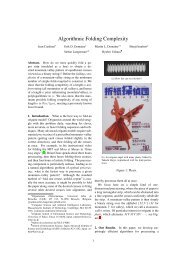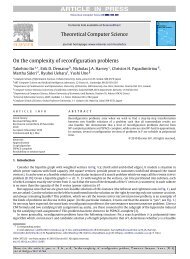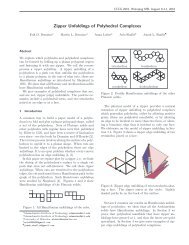Erik D. Demaine Martin L. Demaine - Erik Demaine
Erik D. Demaine Martin L. Demaine - Erik Demaine
Erik D. Demaine Martin L. Demaine - Erik Demaine
Create successful ePaper yourself
Turn your PDF publications into a flip-book with our unique Google optimized e-Paper software.
<strong>Erik</strong> D. <strong>Demaine</strong><strong>Martin</strong> L. <strong>Demaine</strong>MIT Laboratory for Computer Science200 Technology Square, Cambridge, MA 02139, USA{edemaine, mdemaine}@mit.eduAbstractWe present one hinged dissection of a square that can be folded into every letter ofa polyabolo alphabet.Hinged dissections. Hinged dissection is a particular form of dissection in which oneshape is sliced into pieces and hinged at their vertices so that the mechanism can be foldedinto another shape or shapes. The classic example is the hinged dissection of an equilateraltriangle to a square described by Dudeney and shown in Figure 1; see [1] for the historyof this dissection, as well as some other hinged dissections. Recently, Frederickson [2] haswritten a book devoted entirely to hinged dissections and techniques for designing them.Figure 1: Hinged dissection of an equilateral triangle into a square [1].Theory. An intriguing open problem is whether every pair of polygons has a hinged dissection.Recently, there have been two interesting results addressing this problem. Eppstein [3]showed how to hinge-dissect any polygon into its mirror image. Eppstein, Frederickson,Friedman, and the present authors [4] demonstrated a wide family of hinged dissections forpolyforms, that is, shapes made up of repeated copies of a common polygon glued togetheredge-to-edge. Examples of polyforms include polyominoes, polyiamonds, polyhexes, andpolyaboloes. The hinged dissections of [4] are cycles (closed chains) of pieces, which is evenmore restrictive than the standard open chains of pieces as in Figure 1.1
Polyaboloes. Here we focus on polyforms called polyaboloes, which are made up of congruentright isosceles triangles (half-squares). In this context, the basic idea of the hingeddissections in [4] is to split each right isosceles triangle into four subtriangles and hinge themtogether as shown in Figure 2(a). Then these four-piece hinged dissections of right isoscelestriangles can be combined together edge-to-edge by breaking them at the midpoint of thecommon edge; see Figure 2(b) for the case of two triangles. In general, for an n-abolo, thehinged dissection has 4n pieces.(a) Monabolo.(b) Diabolos.Figure 2: Hinged dissections from [4] for small polyaboloes.Alphabet. We have designed an alphabet in which every letter and digit is a 32-abolo, asshown in Figure 3. A 4 × 4 square is also a 32-abolo. Thus, from the results of [4], we obtaina single hinged dissection with 128 pieces that folds into all letters and digits and the 4 × 4square. Two example foldings of this hinged dissection, one for the letter A and the otherfor the square, are shown in Figure 4.Related work. Harry Lindgren [5] designed dissections of individual rectilinear letters toa square, specifically E, F, H, I, L, M, N, T, V, W, X, Y, and Z. To make the dissectionssimilar, he decided that each letter would have a height five times the thickness of the strokes.Our work in some sense strengthens these results, both to hinged dissections and to all lettersand digits.Alphabet design. The letters and digits all have height 7 and area 16. The main motivationfor these parameters is to make the area a square number, so that the hinged dissectioncould fold into an integral square. An area of 9 is too small for a good-looking alphabet(consider e.g. the digit 8 or letter B).2
Figure 3: The 32-abolo alphabet.Figure 4: Foldings of the 128-piece hinged dissection into the letter A and a square.3
References[1] Greg N. Frederickson. Dissections: Plane and Fancy. Cambridge University Press, 1997.[2] Greg N. Frederickson. Hinged Dissections: Swinging & Twisting. To be published byCambridge University Press, May 2002.[3] David Eppstein. Hinged kite mirror dissection. arXiv paper cs.CG/0106032, June 2001.http://arXiv.org/abs/cs.CG/0106032.[4] <strong>Erik</strong> D. <strong>Demaine</strong>, <strong>Martin</strong> L. <strong>Demaine</strong>, David Eppstein, Greg N. Frederickson, and ErichFriedman. Hinged dissection of polyominoes and polyforms. arXiv paper cs.CG/9907018,November 1999. http://arXiv.org/abs/cs.CG/9907018. A preliminary version appearsin Proceedings of the 11th Canadian Conference on Computational Geometry, 1999.[5] Harry Lindgren. Rectilinear letters. In Recreational Problems in Geometric Dissectionsand How to Solve Them, chapter 18, pages 76–83. Dover Publications, Inc., 1972. Revisedand enlarged by Greg Frederickson.4
















